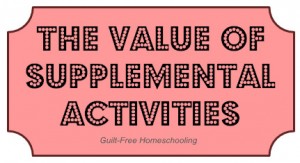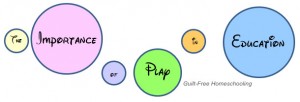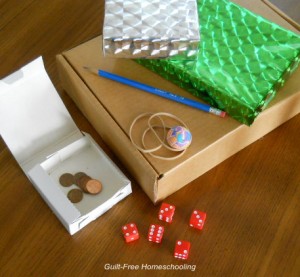A friend recently posed an intriguing question to a group of homeschooling moms: “If money were no object, what would you purchase first for your homeschool?” The usual wish-list items came out: specific curriculum choices, books, more books, shelves for all the books, rooms just for school stuff, and books. However, I was the most surprised by reading a spontaneous part of my own answer: “For us, it wasn’t the curriculum itself that ‘made’ homeschooling — it was the extra-curricular activities and supplemental things we did that we remember most and learned the most from.” It was an aspect of homeschooling that I had never truly pondered before, at least not in so many words. I have often suggested various activities to help struggling students bridge the learning styles gap with assorted curricula, but suddenly I was seeing activities as The Most Important Part of any homeschooling experience.
It is not the curriculum itself that matters most; it is what you do with the program and what you do besides the program that will make all the difference in your homeschooling endeavor. Supplemental activities can turn a mediocre program into an educational experience far better than the most renowned program on the market. The activities you choose can be tailored to your child’s individual needs and interests, whereas a boxed program must be universally applicable.
Some programs are better than others, but that still goes only so far. My regular readers already know how much I loved Miquon Math for grades 1-3, but the suggested activities were what really drove the concepts home. Practice away from the workbooks and playing and experimenting with Cuisenaire rods are what solidified the knowledge that was presented in the books. Saxon Math effectively used real-life examples through word problems to teach the students how to set up a formula. (Once they have the formula, any math student can solve the formula.) Our supplemental activities for Saxon math included applying the formulas to more areas of real life: relating fractions to pies and candy bars, doubling recipes for practice using fractions, calculating the areas, perimeters, and angles for home improvement projects, and applying the mathematics of probabilities to everyday situations in my students’ lives. When my daughter had trouble understanding probability from the textbook example of red marbles and blue marbles, I changed the problem to fit her teddy bear collection. Suddenly, her favorite white polar bear stood out in marked contrast to the other bears, and the chances of selecting him at random from a pile of stuffed bears was more easily understood.
We played a great deal with construction toys, but we always built something, even if our projects were not elaborate architectural models. We never stacked the bricks just for the sake of stacking bricks. Instructions for Erector Set models or K’nex figures were a launching pad for our imaginations as we challenged ourselves to combine patterns or build bigger or better designs. Real life usually requires you to have some type of plan, so our activities always had a basic plan as well. We dared to dream, and we learned through the trying, whether we succeeded or not.
We are all familiar with the jokes about students who put a book underneath their pillows, hoping to absorb information by osmosis while they slept. We smile and laugh, knowing that there is no possible way for that to happen, but many times we urge a child to “read the book,” expecting him to absorb all the information in that manner. If the child is adept at visual learning, it may happen, but so much more knowledge and understanding can be gained through the addition of a few supplemental activities. Activities break down the barriers of learning styles, making it possible to teach your child in the way he learns best, no matter what curriculum you are using.
When I took a college chemistry course, I worked industriously at memorizing vast quantities of information. They were only meaningless words to me, but I forced myself to memorize them so that I could reproduce them on test papers. However, through working in the chemistry lab, experimenting with the acids, bases, minerals, and gases, I began to understand the concepts behind those words. I had read the book, and I had learned the facts, but I did not gain understanding until I got into a supplemental activity. Watching bubbles form in a beaker of water as electrodes forced the hydrogen and oxygen molecules to separate made the atomic bonding process straightforward and uncomplicated. It was right there in front of me. I could watch it happen. I collected bubbles of the two gases in separate test tubes and proved their identities with another test. A similar experiment electroplated a nickel coin with the copper from a penny. The diagrams my professor scribbled on the chalkboard became stop-motion animations of the molecular breakdown process. He showed me through symbols and arrows the explanation for what I saw forming in the beaker. It was not sleight-of-hand illusion; it was science taking place at my fingertips. It was not something I could learn sufficiently from merely reading a book. I had read about the process, but actually doing it made the reading portions of my lesson obsolete.
Supplemental activities do not have to be expensive or use fancy materials. Many wonderful, educational activities can be obtained from the simple things you already have around the house.
* Read aloud and discuss plot lines, characters, and what-do-you-think-will-happen-next.
* Play with art and craft materials, even if you have no natural artistic ability whatsoever. If you have difficulty drawing, get off the paper and try “sculpting” with Play-Doh — maybe you are more of a three-dimensional thinker.
* Draw diagrams, even if you have no natural artistic ability whatsoever. The simple chalkboard illustrations that have helped me gain understanding were not artistic or even dimensionally accurate, but I still learned and understood.
* Use manipulatives: hands-on learning aids, whether they are homemade flash cards, things for counting and sorting, or a clock-face made from a paper plate and cardboard “hands.” If it helps your student understand a concept, it is worth your time, trouble, and expense.
* Build models. Who cares if popsicles sticks do not resemble quality building materials? I bought my students a small package of pre-notched “popsicle” sticks (think miniature, flat Lincoln Logs) in the craft department of Wal-Mart. They never looked like much when we built things with them, but the knowledge gained from the process of fitting them together was irreplaceable.
* Do experiments. A vinegar and baking soda reaction is fascinating to someone who has never watched it before. Woodburning with nothing more than a magnifying glass and the sun is another unforgettable experience (especially when you stop paying attention to where you have the light focused and your leg suddenly gets hot).
* Play games. Children sometimes balk at spending more time studying their lessons, but have you ever had a child turn down the chance to play a game? Any game using money is math; many games require forethought and strategy, and all games teach sportsmanship. Get together with other homeschooling families and share your favorite games with each other.
* Invent a new game: take a concept that your students need work on and invent a new game for practicing that concept. Make the pieces yourself or borrow them from other games and write all the necessary rules for some real-life problem-solving experience. I dare you to try it.
* Take on hosting a group project (even if it is nothing more than a Monopoly marathon) and enlist your students to help you plan and execute it. We learned much more from preparing large-scale events than we ever could have learned from merely participating in them. My daughter first ventured into administrative duties when we tackled an event that combined several homeschool support groups. The skills she developed then still serve her today in retail management.
* GO see things and DO stuff: zoos, museums, libraries, etc. A “family pass” will often be usable at more than one location. We purchased a season-long family pass to a small local zoo, only to find that it also entitled us to free admission to a much larger zoo in another city an easy day-trip away. Our pass also included other zoos, history museums, art museums, and science museums for a full year. For a little more than the standard admission for one family visit, we were able to take in multiple wonderful experiences. Another amazing surprise for me was how fascinating unfamiliar libraries were to my children. We dropped by the public library in another city and ended up spending hours exploring it and seeing how its features differed from our local library. Whether you take an extended, educational, family vacation or just walk around your neighborhood noticing the architectural differences, it can be a memorable learning experience.
Anything that takes place outside of the textbooks or outside of the house is always memorable. If I were to ask my children to name their “Top 10 Favorite Things” from our homeschooling days, none of their responses would include the textbooks we used. Their “Top 1,000” list would barely touch on textbooks. Let me say this again: it is not the curriculum itself that matters the most. It is what you do with the program and what you do besides the program that will make all the difference in your homeschooling experience.





 Guilt-Free Homeschooling is the creation of Carolyn Morrison and her daughter, Jennifer Leonhard. After serious disappointments with public school, Carolyn spent the next 11 years homeschooling her two children, from elementary to high school graduation and college admission. Refusing to force new homeschooling families to re-invent the wheel, Carolyn and Jennifer now share their encouragement, support, tips, and tricks, filling their blog with "all the answers we were looking for as a new-to-homeschooling family" and making this website a valuable resource for parents, not just a daily journal. Guilt-Free Homeschooling -- Equipping Parents for Homeschooling Success!
Guilt-Free Homeschooling is the creation of Carolyn Morrison and her daughter, Jennifer Leonhard. After serious disappointments with public school, Carolyn spent the next 11 years homeschooling her two children, from elementary to high school graduation and college admission. Refusing to force new homeschooling families to re-invent the wheel, Carolyn and Jennifer now share their encouragement, support, tips, and tricks, filling their blog with "all the answers we were looking for as a new-to-homeschooling family" and making this website a valuable resource for parents, not just a daily journal. Guilt-Free Homeschooling -- Equipping Parents for Homeschooling Success!

Recent Comments